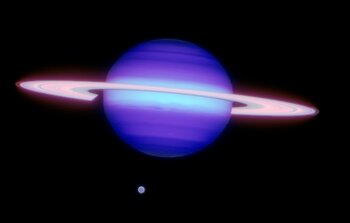Storm Brews Over Titan's Tropical Desert
August 12, 2009

While far from a tropical rain forest, the equatorial region of Saturn’s largest moon, Titan, has recently displayed tantalizing evidence that the parched, dry, ultra-frigid desert can support large-scale storms.
The research, published in the August 13, 2009 issue of the journal Nature, announces the discovery of significant cloud formation (about three million square kilometers) within the moon’s tropical zone near its equator. Prior to this event (in April 2008) it was not known whether significant cloud formation was possible in Titan’s tropical regions. This activity in Titan’s tropics and mid-latitudes also seems to have triggered subsequent cloud development at the moon’s south pole where it was considered improbable due to the Sun’s seasonal angle relative to Titan.
The evidence comes from a team of US astronomers using the Gemini North telescope and NASA’s Infrared Telescope Facility (IRTF) both on Hawaii’s Mauna Kea. “We obtain frequent observations with IRTF giving us a ‘weather report’ of sorts for Titan. When the IRTF observations indicate that cloud activity has increased, we are able to trigger the next night on the Gemini telescope to determine where on Titan the clouds are located,” said team member Emily Schaller of the University of Hawai‘i (when this work was conducted). In fact, in the past eight years of monitoring at Gemini no significant clouds over Titan’s tropical regions were spotted.
Titan, the solar system’s second-largest moon, has received considerable attention by scientists since NASA’s Cassini mission deployed the Huygens probe that descended through the moon’s atmosphere in January 2005. During its descent, the probe’s cameras revealed small-scale channels and what appear to be stream beds in the equatorial regions that seemed to contradict atmospheric models predicting extremely dry desert-like conditions near the equator. Until now these erosional (fluvial) features have been explained by the possibility of liquid methane seeping out of the ground.
"In April 2008 we observed what was a global event that shows how storm activity in one region can trigger clouds, and probably rainfall, over arid regions, such as the tropics where Huygens landed," said team member Henry Roe from Lowell Observatory. Roe adds, "Of course these rain showers are not liquid water like here on Earth, but are instead made of liquid methane. Just like the streambeds and channels that are carved by liquid water on Earth, we see features on Titan that have been created by flowing liquid methane."
Unlike the Earth, on Titan, where the temperature is some -178 degrees Celsius, methane (or natural gas) is a liquid and it is the dominant driver of the moon’s weather and surface erosion. Any water on Titan is frozen on or below the moon’s frigid surface and resembles rocks or boulders on Titan's surface.
Mid-latitude and polar cloud formations have been observed for many years (by this team and others)but the combination of extensive monitoring at the IRTF with rapid follow-up using Gemini allowed the team to capture the process as it unfolded near the equator. The team monitored Titan on 138nights over 2.2 years and during that time cloud cover was well under one percent. Then, mid-April of 2008, just after team member and Ph.D. candidate Schaller had handed in her doctoral dissertation focusing on Titan’s minimal cloud cover she noticed the dramatic increase in cloud cover.
During this three-week episode clouds forming at about 30 degrees south latitude were observed, followed several days later by clouds closer to the equator and at the moon’s south pole. The apparent connection between the cloud formations leads to the possibility that cloud formation in one area of the moon can instigate clouds in other areas by a process known as atmospheric teleconnections. This same phenomenon occurs in the Earth’s atmosphere and is caused by what are called planetary Rossby waves which are well understood.
The high-resolution Gemini images of Titan were all obtained with adaptive optics technology which uses a deformable mirror to remove distortions to light caused by the Earth’s atmosphere and produce images showing remarkable detail in the tiny disk of the moon. “Without this technology this discovery would be impossible from the surface of the Earth,” said Schaller.
Currently the Cassini spacecraft is orbiting Saturn but only flies by Titan once every 6 weeks or so. This makes continuous ground-based monitoring important for studying features like these with shorter periods on the order of 3 weeks–like this storm.
Links
- PRESS RELEASE (Also see releases by: National Science Foundation and University of Hawai‘i–IfA)
- SPECIAL NOTICE TO JOURNALISTS: On Monday, Aug. 10, 2009, the National Science Foundation hosted a Phone/Webcast call-in with some of the research team responsible for this result. Listen to an audio recording of this event.
- Listen to podcast interview with Principal Investigator Emily Schaller.
Contacts
Peter Michaud
pmichaud@gemini.edu
1 (808) 974-2510
1(808) 936-6643
Gemini Observatory
Hilo, HI 96720
Joshua Chamot
jchamot@nsf.gov
(703) 292-7730
National Science Foundation, Arlington, VA
Henry Roe
hroe@lowell.edu
(928) 233-3218
Lowell Observatory, Flagstaff, AZ
Emily Schaller
schaller@ifa.hawaii.edu
(386) 846-4739
Institute for Astronomy, Honolulu, HI(now at University of Arizona)

